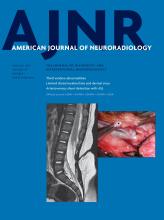Index by author
Curtin, H.D.
- HEAD & NECKOpen AccessSpectrum of Third Window Abnormalities: Semicircular Canal Dehiscence and BeyondM.-L. Ho, G. Moonis, C.F. Halpin and H.D. CurtinAmerican Journal of Neuroradiology January 2017, 38 (1) 2-9; DOI: https://doi.org/10.3174/ajnr.A4922
Cuvinciuc, V.
- SPINEYou have accessDynamic Contrast-Enhanced MR Perfusion of Intradural Spinal LesionsV. Cuvinciuc, M. Viallon, I. Barnaure, M.I. Vargas, K.-O. Lovblad and S. HallerAmerican Journal of Neuroradiology January 2017, 38 (1) 192-194; DOI: https://doi.org/10.3174/ajnr.A4995
Damjanovic, D.
- EDITOR'S CHOICEADULT BRAINOpen AccessHippocampal and Deep Gray Matter Nuclei Atrophy Is Relevant for Explaining Cognitive Impairment in MS: A Multicenter StudyD. Damjanovic, P. Valsasina, M.A. Rocca, M.L. Stromillo, A. Gallo, C. Enzinger, H.E. Hulst, A. Rovira, N. Muhlert, N. De Stefano, A. Bisecco, F. Fazekas, M.J. Arévalo, T.A. Yousry and M. FilippiAmerican Journal of Neuroradiology January 2017, 38 (1) 18-24; DOI: https://doi.org/10.3174/ajnr.A4952
Brain dual-echo, 3D T1-weighted, and double inversion recovery scans were acquired at 3T from 62 patients with relapsing-remitting MS and 65 controls. Focal WM and cortical lesions were identified, and volumetric measures from WM, cortical GM, the hippocampus, and deep GM nuclei were obtained. Compared with those with who were cognitively preserved, patients with MS with cognitive impairment had higher T2 and T1 lesion volumes and a trend toward a higher number of cortical lesions. Significant brain, cortical GM, hippocampal, deep GM nuclei, and WM atrophy was found in patients with MS with cognitive impairment versus those who were cognitively preserved. The authors conclude that hippocampal and deep GM nuclei atrophy are key factors associated with cognitive impairment in MS.
Dargazanli, C.
- INTERVENTIONALYou have accessImpact of Modified TICI 3 versus Modified TICI 2b Reperfusion Score to Predict Good Outcome following Endovascular TherapyC. Dargazanli, A. Consoli, M. Barral, J. Labreuche, H. Redjem, G. Ciccio, S. Smajda, J.P. Desilles, G. Taylor, C. Preda, O. Coskun, G. Rodesch, M. Piotin, R. Blanc and B. LapergueAmerican Journal of Neuroradiology January 2017, 38 (1) 90-96; DOI: https://doi.org/10.3174/ajnr.A4968
De Craen, A.J.M.
- ADULT BRAINOpen AccessInfluence of Small Vessel Disease and Microstructural Integrity on Neurocognitive Functioning in Older Individuals: The DANTE Study LeidenJ.E.F. Moonen, J.C. Foster-Dingley, A.A. van den Berg-Huijsmans, W. de Ruijter, A.J.M. de Craen, J. van der Grond and R.C. van der MastAmerican Journal of Neuroradiology January 2017, 38 (1) 25-30; DOI: https://doi.org/10.3174/ajnr.A4934
Dehkharghani, S.
- ADULT BRAINYou have accessBody Temperature Modulates Infarction Growth following Endovascular ReperfusionS. Dehkharghani, M. Bowen, D.C. Haussen, T. Gleason, A. Prater, Q. Cai, J. Kang and R.G. NogueiraAmerican Journal of Neuroradiology January 2017, 38 (1) 46-51; DOI: https://doi.org/10.3174/ajnr.A4969
- FUNCTIONALYou have accessThe Effects of Acetazolamide on the Evaluation of Cerebral Hemodynamics and Functional Connectivity Using Blood Oxygen Level–Dependent MR Imaging in Patients with Chronic Steno-Occlusive Disease of the Anterior CirculationJ. Wu, S. Dehkharghani, F. Nahab, J. Allen and D. QiuAmerican Journal of Neuroradiology January 2017, 38 (1) 139-145; DOI: https://doi.org/10.3174/ajnr.A4973
Demchuk, A.M.
- FELLOWS' JOURNAL CLUBINTERVENTIONALOpen AccessEndovascular Therapy of M2 Occlusion in IMS III: Role of M2 Segment Definition and Location on Clinical and Revascularization OutcomesT.A. Tomsick, J. Carrozzella, L. Foster, M.D. Hill, R. von Kummer, M. Goyal, A.M. Demchuk, P. Khatri, Y. Palesch, J.P. Broderick, S.D. Yeatts, D.S. Liebeskind and for the IMS III InvestigatorsAmerican Journal of Neuroradiology January 2017, 38 (1) 84-89; DOI: https://doi.org/10.3174/ajnr.A4979
The authors reviewed the impact of revascularization on clinical outcomes in 83 patients with M2 occlusions in the Interventional Management of Stroke III trial according to specific M1–M2 segment anatomic features. AnmRS 0–2 outcome was associated with reperfusion for M2 trunk (n = 9) or M2 division (n = 42) occlusions, but not for M2 branch occlusions (n = 28). Of the 83 participants with M2 occlusion who underwent endovascular therapy, 41.0% achieved mRS 0–2 at 90 days, including 46.6% with modified TICI 2–3 reperfusion compared with 26.1% with modified TICI 0–1 reperfusion. They conclude that mRS 0–2 at 90 days was dependent on reperfusion for M2 trunk but not for M2 branch occlusions in IMS III.
De Ruijter, W.
- ADULT BRAINOpen AccessInfluence of Small Vessel Disease and Microstructural Integrity on Neurocognitive Functioning in Older Individuals: The DANTE Study LeidenJ.E.F. Moonen, J.C. Foster-Dingley, A.A. van den Berg-Huijsmans, W. de Ruijter, A.J.M. de Craen, J. van der Grond and R.C. van der MastAmerican Journal of Neuroradiology January 2017, 38 (1) 25-30; DOI: https://doi.org/10.3174/ajnr.A4934
Desilles, J.P.
- INTERVENTIONALYou have accessImpact of Modified TICI 3 versus Modified TICI 2b Reperfusion Score to Predict Good Outcome following Endovascular TherapyC. Dargazanli, A. Consoli, M. Barral, J. Labreuche, H. Redjem, G. Ciccio, S. Smajda, J.P. Desilles, G. Taylor, C. Preda, O. Coskun, G. Rodesch, M. Piotin, R. Blanc and B. LapergueAmerican Journal of Neuroradiology January 2017, 38 (1) 90-96; DOI: https://doi.org/10.3174/ajnr.A4968
De Stefano, N.
- EDITOR'S CHOICEADULT BRAINOpen AccessHippocampal and Deep Gray Matter Nuclei Atrophy Is Relevant for Explaining Cognitive Impairment in MS: A Multicenter StudyD. Damjanovic, P. Valsasina, M.A. Rocca, M.L. Stromillo, A. Gallo, C. Enzinger, H.E. Hulst, A. Rovira, N. Muhlert, N. De Stefano, A. Bisecco, F. Fazekas, M.J. Arévalo, T.A. Yousry and M. FilippiAmerican Journal of Neuroradiology January 2017, 38 (1) 18-24; DOI: https://doi.org/10.3174/ajnr.A4952
Brain dual-echo, 3D T1-weighted, and double inversion recovery scans were acquired at 3T from 62 patients with relapsing-remitting MS and 65 controls. Focal WM and cortical lesions were identified, and volumetric measures from WM, cortical GM, the hippocampus, and deep GM nuclei were obtained. Compared with those with who were cognitively preserved, patients with MS with cognitive impairment had higher T2 and T1 lesion volumes and a trend toward a higher number of cortical lesions. Significant brain, cortical GM, hippocampal, deep GM nuclei, and WM atrophy was found in patients with MS with cognitive impairment versus those who were cognitively preserved. The authors conclude that hippocampal and deep GM nuclei atrophy are key factors associated with cognitive impairment in MS.








